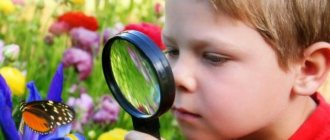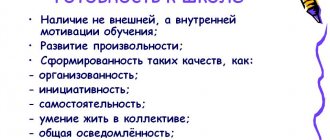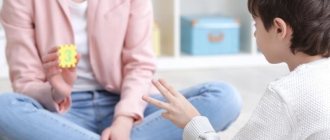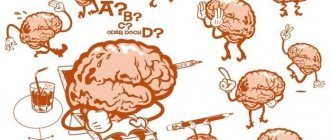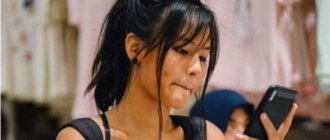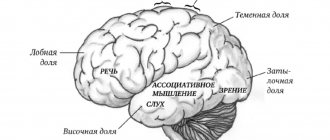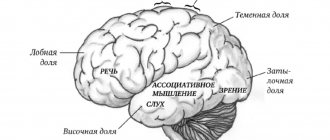At the present stage, preschool education plays a big role. Even more and more demands are placed on children of senior preschool age every year, especially in senior preschool age before directly entering school. Children must learn to comprehend educational information before they set foot in school.
Often, children of senior preschool age are prepared for school by instilling in them general and special knowledge, certain skills and certain skills. But they do not attach importance to the formation of their cognitive mental processes, and first of all, perception. But this is no less important. And maybe even the basis for successful schooling. After all, if a child of senior preschool age does not learn to perceive information, he will not be able to comprehend, process and evaluate it. The child will not master the school material and curriculum; his knowledge will not be formed.
Perception of the world in preschool age
Preschoolers are attracted to bright objects, melodic or original sounds, and emotional situations. They perceive the surrounding reality involuntarily, directing their attention to what attracts them most.
A child, seeing an object, is able to evaluate the functions known to him, intuitively analyze his experience and understand what he sees, hears or feels. A little baggage of life experience helps to understand what kind of sensation it is, to recognize an object, sound or smell.
The development of perception in preschool children allows them to move to the next step, when they learn to purposefully study objects, determine their characteristics, and differentially perceive individual properties.
What is a child's perception
Over the course of several preschool years, a child goes from directly perceiving an object through touch to the ability to isolate essential features and form a generalized idea of objects.
The function of cognition works as follows: perception arises as a reflection of a phenomenon or object using vision, hearing or touch.
Perception or perception is the process of receiving and transforming information using the senses, thanks to which a person develops a picture of the real world.
The perception mechanism can be briefly described as follows:
- The world around us consists of many signals: sounds, colors, pictures, tangible objects;
- By inhaling a smell or touching a piece of paper, the baby evaluates the object using one of the senses;
- This information enters the brain, where the sensation is born;
- Sensations add up to a complex picture, forming perception.
Perception is also influenced by previous experience. The senses help the child reduce information processing where he sees a familiar environment. Having received an idea of the toy bunny once, he will not need to touch or taste it again.
Perception is the basis for the further formation of cognitive functions necessary for full development and successful study.
Formation of sensation and perception processes
From birth, a child has what is called sensory perception. Smells, tactile sensations, and noise reach his brain, but the baby does not yet know how to use these signals. In the first years of life, children master object-related activities and accumulate information about the properties of objects, as a result of which sensory standards are formed.
From the age of three, perception gradually becomes accurate and meaningful. The higher visual and auditory analyzers are developing.
The child cannot yet comprehensively analyze an object or phenomenon, but he grasps the most noticeable signs, involuntarily comparing them with standards and drawing conclusions.
From a general understanding of objects at 3-4 years old, the youngest preschooler moves on to more complex forms of interpretation. With the active support of adults, the characteristics of sensations change, the child manages to realize that shape, color, material, size are more abstract characteristics and are not tied to a specific object.
By the senior preschool age, the child becomes familiar with the basic figures of geometry, identifies all the colors, and learns to determine the sizes of objects. He also understands that in the world there is a time, morning always turns into day, and then gives way to night. It is an achievement to realize the space from the house to the park, but the houses and trees stretch upward.
The importance of the development of perception in preschool age lies in the fact that with its limited functioning, the development of speech, memory, thinking, attention and imagination will be significantly hampered. This cognitive process becomes a necessary assistant for the manifestation of various types of thinking, the ability to speak figuratively and come up with vivid stories.
Developmental Psychology: Cognitive Processes in Children. Perception and Attention
In this article we begin to look at the processes of cognitive development in children. Every day, children have to solve a number of problems: do math assignments and remember to bring them to school, learn to tie their shoes, and much more. The focus of this chapter is on the cognitive processes that children use to solve everyday problems and how these abilities change and increase during development. We begin by describing changes in attention and memory (children's developing ability to perceive and store information). We then discuss children's increasing ability to understand numbers and solve problems. Finally, we will discuss children's knowledge of their own mental abilities and how their abilities are influenced by the type of tasks they perform and the strategies they use.
Each of these abilities plays a critical role in solving children's everyday problems. Because much of the existing research in the field of child development has focused on the information processing approach, this chapter is broadly based on the abilities that are considered critical to development in this approach. However, keep in mind that each of these abilities is explained in terms of conventional Piagetian theory and neo-Piagetian theory. In addition, these abilities are constantly influenced by the society in which the child develops, so they can be studied from a Vygotskyan sociocultural perspective.
PERCEPTION AND ATTENTION
A group of children who are in the same situation and exposed to the same sensory stimulation do not necessarily receive the same amount of information. Their perception or acquisition of information from the environment may be the same, but their attention is focused on different aspects of the environment. In a school classroom, one child, focused on the teacher, will hear and understand the lesson, while another child, more interested in the whispers of his desk neighbor, may perceive the teacher's voice as an annoying buzz. The effects of the sights, sounds, smells, touches and sensations of movement provided by the environment will depend on what aspects of the situation children pay attention to and what meaning these features have for them.
Changes in what information can be obtained from a situation are associated with the development of both the child's perceptual abilities and his attention strategies. These two processes are closely interrelated. Perception presupposes the capacity for attention, and attention would be meaningless if a person could not gain knowledge from what he observes.
How perception develops
There are two main theories about how experience influences learning and perceptual development. Piaget's enrichment theory suggests that each time a child perceives an object, he learns a little more about it. The first time a child sees a cat, it will seem like nothing more than another furry four-legged animal. The next time he sees the cat, it may be drinking milk and purring. The child refines the cat's understanding schema to include “purrs and loves milk.” Finally, the child tries to lift the cat, but finds that the cat is too heavy. As a result, cats become heavy, furry, four-legged animals that drink milk and purr. With experience, information is added to the existing schema of the object, and it becomes more detailed and elaborate. The sensations derived from a stimulus are meaningless until they are modified and enriched with information from other circuits. The child rebuilds and develops scarce sensory sensations. Because schema enrichment occurs for many objects, the child learns to differentiate between them (Bruner, 1957; Vernon, 1955).
In contrast to enrichment theory, Eleanor Gibson's (1969, 1991, 1992) differentiation theory suggests that sensory object input is a rich source of information. Sensory information is not an impoverished information base that needs to be enriched through schemas or associations, as suggested by enrichment theory. The child's task is to gradually learn to pay attention to, identify and distinguish important features of objects and relationships from a huge stream of sensory information. Thanks to experience, the child learns to distinguish objects and events more and more subtly and pay attention to the features of objects. These features are called invariants, that is, characteristics of objects and relationships between them that do not change under different conditions. Invariants often define the relational characteristics of an object rather than any absolute quality. Thus, a gray cat may appear almost black in dim light, but almost white in bright light on a sunny day. However, if a cat only has a black collar, the rest of the fur will always appear lighter, regardless of the lighting. The brightness ratio of the cat and the collar remains constant (unchanged). Such a cat is always four times brighter than the collar. Thus, the brightness of an object relative to other objects in its environment is a perceptual invariant.
According to Gibson's theory, it is invariants that are relations of the highest order. They describe objects and relationships despite any changes (transformations) in distance or orientation. It is the invariants that the perception system pays special attention to (Gibson, 1991; 1992). The development of perception entails learning to attend to relevant object invariants and the detection of new differences between similar stimuli. Over time, the child learns to distinguish the friendly neighbor cat from the king of the jungle.
Gibson's theory has had a major impact on research and has emphasized the importance of understanding perceptual processing and its impact on attention (Pick, 1992). For an infant, attention is typically controlled primarily by the physical properties of stimuli. However, as children grow older, needs and goals become more of a focus. What is given attention in a particular situation is determined by the demands of tastes and by the goals and strategies that the child brings to the situation.
Attention: selection of perceived objects
When we are interested in a topic, it often seems that attention is what is affecting. In fact, attention is a very multi-level process that is influenced by presentation, the type of information presented, and the complexity of perception. The most difficult aspect of attention for children is the ability to manage attention.
Attention control
Very young children can only maintain their attention for short periods of time, but this ability increases as they develop. Between the ages of 1 and 3 years, children experience a steady increase in the amount of time they spend on objects, such as toys. (Ruff & Lawson, 1990). One-year-old children engage with the toy for only 3.5 seconds. By the age of 3.5 years, children spend more than 8 seconds on one toy. No teacher or parent expects a preschool-age child to exhibit the persistence in play or goal-directed activities that older children exhibit. Even when watching TV, young children are more easily distracted than older children and adults. While watching television, 2- and 3-year-old children often talk, play with toys, and wander around the room (Anderson, Lorch, Field, Collins, & Nathan, 1986). Older children are less distracted and spend more time paying attention to television. However, when young children (3–5 years of age) are fully absorbed in the television program, they are less likely to attend to external audiovisual content (Anderson, Choi, & Lorch, 1987).
Children's attention is influenced by the type of information they perceive. Children are more likely to watch programs that match their intellectual level (Anderson, Lorch, Field, & Sanders, 1981). Too complex programs are of little interest to them. Children are also very sensitive to the importance of information presented. When 4- to 6-year-old children were asked about what they saw, the children were more likely to recall important facts from the program (Lorch, Bellack, & Augsbach, 1987). In addition, children under 6 years of age are more interested in the visual content of programs than in the audio content (Hayes, Chemelski, & Bernbaum, 1981). Thus, when watching Sesame Street, they are more likely to be interested in Big Bird's funny appearance, big feet, awkward movements and crooked expression than in what he says.
Adaptability
In a teaching situation, it is not enough to simply draw the child’s attention to the task. It is very important that he can focus on the important aspects of the task and ignore the unimportant ones. As children grow older, they become able to selectively pay attention to the most important aspects of a situation. For example, Miller and Wyss (1981) presented 7, 10, and 13 year old children with a randomized learning task. It asked people to remember the location of several small animals, each of which was hidden under an individual fabric cover. When the children were shown each of the hidden animals, they also saw a different household item above or below the animal. The goal of this task is to remember the location of a target object (animal) while rejecting an irrelevant object (everyday object). When testing their memory for animal locations, older children performed much better than younger ones. In contrast, when children's memory of irrelevant objects was tested, the opposite pattern was found. Younger children often remembered where household items were hidden, unlike older children. At the same time, the younger children remembered the location of household items no less than the location of animals. A similar technique has also been used to assess children's attentional abilities to images containing relevant and irrelevant information (Day, 1975; Hagen & Hale, 1973) and to information received through either ear (Cherry, 1981; Maccoby, 1967, 1969). ). Young children in these tasks were unable to filter out irrelevant aspects of the situation. Instead, they paid attention to both relevant and irrelevant information.
Research also shows that older children are more flexible than younger children in changing their attention to meet task demands (Hale & Taweel, 1974; Pick & Frankel, 1974). For example, children were shown pictures of dogs and cats and asked to remember the color and number of spots on dogs, but only the color on cats. Older children showed better results. They remembered the color and spots of dogs, but only the color of cats. Young children mostly remembered either both features of cats or forgot the number of spots on dogs. Older children are better able to broaden or narrow their focus of attention effectively across all tasks. This adaptability is very useful. Learning to use different strategies for different tasks is an effective learning skill.
The overall picture from these studies is that the processing of relevant information increases during the early and middle school years. However, processing of irrelevant information remains constant or increases until age 11 or 12 and then decreases. This suggests that older children pay more attention to relevant materials than younger children. This view of children's developmental focus of attention fits well with predictions based on the information-processing view of development. In the information processing approach, development is driven by increased efficiency of the child's cognitive processing abilities. Increasing the ability to attend to relevant aspects of a situation is just one example of one of the cognitive processes suggested by this approach. All this directly affects the child's ability to interact with his environment.
Planning
One of the most striking changes in a child's attention strategies is the development of more organized plans and systematic strategies for collecting and filtering information relevant to problem solving. Imagine that in front of you are drawings of two houses. Each house has six windows. Your task is to determine whether two houses are identical. How can you approach this problem? You'd probably compare six pairs of matching windows in a house, one pair at a time, until you find a pair that doesn't match. If all the windows match, we can conclude that the houses are identical. In an early classic study, Vurpillot (1968) gave this task to young children. The results showed that the younger the child, the less systematically he compared stimuli. He is more likely to make judgments based on inadequate or incomplete samples of information than an older child. A young child may not be able to apply a systematic design to extract the information needed to make a meaningful comparison.
I LOOK BUT I DON'T SEE. A classic study of children's visual scanning strategies
Many problem-solving situations require the child to systematically compare two sets of stimuli to determine whether they are identical or not. Elaine Vurpillot's research on children's eye movements while performing tasks has shown that development occurs in the systematicity of their scanning strategies.
Vurpillot showed the children pairs of houses and asked them to answer whether they were identical or not. Half the houses were the same. The other half differed in that they displayed various items in one, three, or five of the six windows. For example, the top pair of windows are identical, but the bottom pair is different in that the house on the left has a bird cage in the top right window, and the house on the right has plants in that window. Vurpillot filmed the children's eye movements (moving, focusing, stopping) as they compared houses. This analysis showed that young children tend to make random comparisons between houses. They randomly looked out several windows and then answered (often incorrectly) that the houses were similar or different. For example, they did not look at the windows that differentiated the two houses and said that the houses were identical. Older children took a more logical approach, comparing each pair of windows until they discovered the difference.
These results indicate that between the ages of 4 and 9 years, children develop much more organized and systematic strategies for processing visual information.
Source: Vurpillot E. (1968). Development of scanning strategies and their relationship to visual differentiation. Journal of Experimental Child Psychology, 6, 632-650.
Does this study imply that young children cannot plan effective attention strategies? Further research by Miller and Weiss (1981) shows that this is not the case. They modified the incidental learning task described earlier to include information relevant to the location of animals or household items. (The animals were hidden behind pictures of cages, and the instruments were hidden behind pictures of houses.) The 7- and 10-year-olds consistently looked under the cages when they were told that the test would involve pictures of animals. But when they were told that the testing would involve household items, the children began to look behind the houses. Further research showed that children as young as 6 years of age performed well when additional cues were added (e.g., a story connecting all the animals pictured) (Woody-Ramsey & Miller, 1988). Thus, it appears that young children can use a strategy to focus their attention on relevant aspects of the environment when the strategy is simple and readily available (DeMane Dreblow & Miller, 1988).
Original article: E. Mavis Hetherington, Ross D. Parke. Child Psychology. A contemporary viewpoint. Fourth edition, 1993
Author of the translation: Zolotukhina Maria Sergeevna
Editors: Simonov Vyacheslav Mikhailovich, Shipilina Elena Ivanovna
Image source: pexels.com
Keywords: child psychology, scientific psychology, intellectual development of a child, how to raise a smart child, how to help a child study, inattentive child, attention of a young child, attention of a child, mental development of a child, how to develop a child’s attention, why a child is inattentive, Piaget’s theory.
558200cookie-checkDevelopmental Psychology: Cognitive Processes in Children. Perception and Attentionno
Available for download:
- 210421 Developmental Psychology - Cognitive Processes in Children. Perception and Attention
Types of perception in preschoolers based on perceptual systems
The main types of perception in preschoolers are based on various analyzers:
- Visual, allowing you to visually evaluate all the properties of an object;
- Hearing, which helps to learn speech, recognize the native language, feel the sounds of nature, hear music;
- Tactile, providing knowledge of an object through touch.
Auditory
With the help of hearing, the child learns to recognize the sounds of his native language, words and syllables. If in infancy the perception of speech is based on the rhythmic and melodic structure of words and sentences, then already at 1 year the formation of phonemic hearing begins. The baby needs another year for the acceptance of all the sounds of his native language to take shape and for the formation of a sound culture of speech to begin.
The development of auditory perception is most effective during walks, when the baby listens to the noise of the street, birdsong, the sound of rain, and steps. An excellent exercise is to close your eyes and try to understand from which side the bird is singing, or whether a car is driving far or close.
Visual
Visual perception is the leading one in preschool age. The ability to read, see the beauty of the world, and assess danger depends on it. Its leading role is justified by the fact that vision allows you to capture the entire object as a whole, as well as see details.
Visual signals arrive before the preschooler touches or tastes an object. In addition, examining an object is much safer than other methods of research.
Only at an early age, when the baby begins to comprehend the surrounding reality, his hands become his eyes. But at this stage, parents make sure that the child is in a protected space and that only safe objects are in his hands.
According to statistics, the number of visual people (who prefer visual perception) prevails in the world, so the development of this type requires special attention. The task of an adult in preschool age is to sharpen the child’s visual perception, and also to help him expand the range of perceived details.
With preschoolers you need to draw more, study pictures and illustrations. It is these children who enthusiastically engage in appliqué, putting together puzzles and mosaics, continuing to develop their visual senses.
Tactile
Tactile or kinesthetic perception is directly related to touch. Younger preschoolers still trust their hands even more when familiarizing themselves with a new subject. That’s why they so insistently ask to give them something that interests them. More details about tactile perception.
Playing with materials of different structures, modeling, natural substances is a great way to develop the sense of touch. With their eyes closed, children enjoy rolling the foil into balls and smoothing it out. Great joy comes from the exercise of identifying bulk material in a cup. The eyes, of course, must also be blindfolded.
Methods for developing different types of perception
Here are several methods for developing perception of different types.
Size, color and shape
In this case, children are asked to take out objects of only one color from the boxes. Or suggest taking out only square objects, or only round ones. You can prepare boxes painted in different colors, and in them the child must put objects of the color in which the box is painted.
What's lost?
In this game, not only vision and attentiveness work, but also thinking. The child is asked to look at a picture showing different objects. But they are not finished yet. For example, a bicycle is missing a wheel, and a house has no windows. The child must tell what is missing.
Smell and guess
Smell works in this game. The child is blindfolded, in front of him are vegetables and fruits, and other products that the player must name, guided by smell.
Magic sound
A game that awakens the imagination and ears. Child with closed eyes. The presenter plays sounds, including the audio system: the sound of rain, the sound of a steam locomotive, the chirping of birds, etc. The child names who the sounds belong to.
Tactile riddle
There are objects in the container. The child, without looking, must determine by touch what it is. Objects must be of different sizes, shapes, smooth or rough.
Peculiarities of perception in younger preschoolers
In early preschool age, perception is characterized by the following features:
- The inseparability of a property from an object. The big fluffy tiger at the zoo will be called a kitty.
- When studying objects, the most vivid, memorable detail stands out. That is why the wide witch's hat in the picture turns all the elegant old ladies on the street into evil witches.
- A sharp change in the usual surroundings around a familiar object prevents the baby from identifying it. Mom and dad in ballroom dresses become strangers.
Such specificity is typical for children of 3-4 years of age; in the future, perception will become more differentiated, individual functions will be highlighted, and the whole will be fragmented into particulars.
Perception of space by children 3-4 years old
The difficulty of understanding space lies in the inability to touch, smell and see it. The first step is to recognize the close space, that is, the surrounding world at arm's length with a toy.
Subsequently, the younger preschooler begins to understand the concepts of far and near, but they are not precise. The small statues on the bridge may appear to be dolls, and the child may well ask the mother to get one of them.
According to research, in order for a preschooler to begin to correctly perceive space, he must first evaluate his own body in this world. Learn to distinguish and name arms and legs, understand which parts of the body are paired. An additional way to master the concept of space is the constant work of an adult, aimed at indicating the direction. The more often the words are heard: right, left, side, in front, above, the easier it will be for the baby to master orientation in space.
The next stage of the task is to compare length, width and height. Over time, the baby begins to solve such tasks by eye, demonstrating an understanding of what space is and how people and objects are located in it.
Color perception
The difference in colors is available to the baby from an early age. Now we are not talking about the finest shades, but it highlights the main tones of the spectrum.
At 3-4 years old, a preschooler clearly distinguishes 4 primary colors:
- Red;
- Yellow;
- Blue;
- Green.
This aspect is associated with the age-related feature of seeing the main thing, discarding the unimportant, that is, incomprehensible and unknown shades. Data and reference shades are learned casually, without special training. But in order for the baby not to suffer from poor color perception, the names of the remaining tones and shades must be named and shown to him.
Children tend to replace color with the concepts of beautiful and ugly, which results in pictures where the shades of objects do not closely correspond to reality. In this age period, colors are discarded as an unimportant factor, and form becomes the basis.
Therefore, the development of color perception should consist of exercises where the simplest tasks of adding up an elementary color figure are replaced by more complex ones.
Peculiarities of perception in older preschoolers
Senior preschool age is marked by the presence of formed spatial representations. The child is well oriented in space, perceives distances and relationships between objects, and is able to visually model part of a specific room. He is also able to construct a model of the plot of a story or fairy tale.
The future schoolchild is already able to evaluate such an abstract concept as time, as well as see the world around him from an aesthetic point of view. It is these two areas that require the most attention.
Perception of time
The main features of perception in children of senior preschool age are the awareness of the combination of space and time. However, the inability to hear or touch these quantities leads to their prolonged recognition.
A child of 5-6 years old is able to remember time periods: yesterday, today, tomorrow, minute, hour, but there are no skills in using these concepts. The uniqueness of the perception of time is due to the fact that the child does not have the opportunity to manipulate it in a direction, and the terms are simply words that do not have a visual expression.
At this age, time indicators of the sequence of events yesterday, tomorrow, and the day after tomorrow are still poorly differentiated. The future tense is already realized, but the past causes difficulty. Preschoolers are happy to say who they will be when they grow up, what they will have, what they will do. They perceive the past discretely and emerge in the images of remembered events.
Adults will help the child perceive small periods of time if they correlate his activities with the time interval: draw a house with a garden in 10 minutes, sit at the table in 3 minutes, brush your teeth in 1 minute.
Aesthetic perception
But aesthetic perception blossoms magnificently. In older preschool age, every child is a creator. Children sculpt, draw, design, these activities help them understand the world better.
Much of the credit for this activity goes to visual perception. An older preschooler learns to examine objects holistically, tracing the outline and isolating details.
This information becomes a model that the child follows in his drawing and modeling.
If a five-year-old child’s judgment about aesthetics is determined by appearance, and objects are evaluated on the basis of like or dislike, then at the age of 6-7 a preschooler pays attention to artistic composition and color compatibility. For example, in a painting he is already able to capture characteristics that are not on the surface, which the artist put into the content.
The task of parents and educators is not just to inform the child about the beauty of this or that object. It is important to explain in clear words what exactly ensures the aesthetics of a phenomenon, the relationship between individual features and the overall result.
Regular activities of this nature help to cultivate a sense of beauty in a little person. He will learn to see beauty in the sound of drops on glass or falling leaves.
Methods for diagnosing the level of development of perception for children 6-7 years old
"Name the objects"
Equipment: 3 drawings in which different, but well-known to children, objects are “hidden”. In total, the pictures show 14 items. Stopwatch. The task is completed within a minute. If the child spent more than a minute, the result is not counted.
Instructions: the child is shown a picture, he must sequentially name all the objects hidden on it. The next picture is presented only if the answer is complete and correct.
Test “Name the objects” for 6-7 years oldEvaluation of results:
| Number of points | Time spent (sec) | Conclusion about the level of development of perception |
| 10 | less than 20 | Very tall |
| 8-9 | 21-30 | High |
| 6-7 | 31-40 | Average* (upper limit of normal) |
| 4-5 | 41-50 | Average (lower limit) |
| 2-3 | 51-60 | Short |
*The average level corresponds to the age norm.
“What did the artist forget to draw?”
Equipment: 7 drawings (pictures) of objects, each missing one essential detail. Stopwatch.
Test “What the artist forgot” for children 6-7 years old
Instructions: Look carefully. Each picture is missing an important detail. Name her. The result is counted if the missing details in all the pictures are named.
| Number of points | Time spent (sec) | Conclusion about the level of development of perception |
| 10 | less than 25 | Very tall |
| 8-9 | 26-30 | High |
| 6-7 | 31-35 | Average (upper limit of normal) |
| 4-5 | 36-40 | Average (lower limit) |
| 2-3 | 41-45 | Short |
| 0-1 | 45 or more | Very low |
https://youtube.com/watch?v=NH13hKE_ueQ
I like it I don't like it
Ways to develop the perception of preschoolers
In preschool age, the leading activity is play. It is in this form that children learn and develop the necessary functions in the best way.
Didactics presents many games for the development of perception that will help parents or educators engage with their child:
- Droplets teach how to combine objects based on color criteria. When completing the task, you need to put mugs of the corresponding shades in containers.
- Umbrellas form an understanding of the shape and color of objects. To play you need 4 umbrellas of primary colors and cardboard geometric shapes. The teacher reports that it is raining, it is urgent to hide the circles and triangles under umbrellas of different colors.
- A bag of secrets allows you to identify an object based on tactile sensations. An opaque bag is filled with toys. The child, without looking, must describe what came into his hand.
Similar games are played to develop the ability to recognize an object or item by smell or sound.
Regular classes to develop perception in preschoolers will ensure the further formation of a holistic, moral personality. Such a person will most likely have unconventional thinking and a high level of creativity.
Games that develop the perception of middle preschoolers
"Bag of Secrets"
The game promotes the development of:
- the ability to recognize objects by their basic characteristics;
- based on tactile sensations, verbally describe the properties of an object.
Guessing game or “What’s in the bag” Equipment: an opaque bag made of any material, no more than 6 toys or just small objects made from different materials.
Instructions: choose a driver. He will have to guess the name of the toy (item) based on its properties. We invite one of the children to feel the toy in the bag with their hand and name its main properties. After the correct answer, the children change places.
“Whose sound is that?”
The game develops:
- auditory perception;
- the ability to recognize objects by certain properties (sounds).
Equipment: about 10 items made of various materials. This could be a spoon and a cup, a glass of water, a piece of paper, a plastic bag: anything that can produce characteristic sounds when manipulated.
Instructions: an adult hides behind a screen and makes sounds using objects: tears a sheet of paper, imitates the sound of stirring liquid with a spoon, crunches a plastic bag, knocks on the door, pours water from one container to another.
Children must guess which object each sound belongs to.
It is possible to complicate the task: children must name other objects that make similar sounds.
"Guess by the smell"
Game objectives:
- development of smell as a form of perception;
- consolidation of the ability to recognize objects by their essential characteristics (smell).
Game “Guess by smell” with closed eyes Equipment: coffee beans, orange or lemon, perfume, essential oils with the smell of pine needles, strawberries and any other items with a characteristic smell.
Instructions: the driving child is blindfolded with a scarf and asked to recognize and name the object by its smell. If the task is difficult, you can use hints in the form of indicating other characteristic properties of this item.
Mechanism and types of perception
For the full development and effective learning of a child, a sufficient level of development of perception is necessary. It is the basis for the formation of other cognitive processes (memory, attention, thinking, speech and imagination). How does the process of perception occur?
- The world around us consists of various objects and phenomena that can be seen, heard, touched, tasted, smelled.
- With the help of our senses we learn about what an object is. For example, an orange has the following properties: round, orange, smooth, with small dimples on the peel, sour, and has a specific citrus smell.
- Information from the senses enters the brain, where individual sensations are combined into a holistic picture - perception.
- Perception is greatly influenced by accumulated life experience. If a child has already seen and eaten an orange, he does not need to taste it to guess what it is.
Classification of types of perception:
- Visual perception allows you to obtain a visual image of an object, as well as study its details;
- Auditory perception makes it possible to understand speech, recognize various sounds of nature, household noises and hear music;
- Tactile perception - cognition of objects using touch;
- Olfactory perception , recognition of odors;
- Taste perception - receiving information from taste buds (perception of sweet, salty, sour and bitter).
Most experts believe that each of us has a leading channel for receiving data about the world (usually vision, hearing or touch). Pay attention to the form in which your baby better assimilates information; it should be the main one in his learning.
Perception of what it is
In psychology, perception is understood as the process of reflecting reality in all its interrelations. A person receives signals from the environment through various senses. From them, information enters the brain, where it is “processed” and “generates” sensations.
An important role in perception is played by a person’s activity, his speech and the “baggage” of accumulated life experience.
All this allows us to see not only the properties of individual objects, but also to perceive a full picture of the reality around us.
Sensory perception in young children
A person’s ability to perceive information, unlike the ability to do so, is not innate. When a child is born, he learns to do this. He sees objects, hears certain sounds, feels touch and smells. This is evidence of the formation of the perception mechanism. But the child cannot use it - he does not know how yet.
The meaning of perception
The importance of the perception process is difficult to overestimate. This is the basis of human knowledge, the foundation for its further development. Knowledge of the world begins with perception, which involves the inclusion of other mental operations: attention, thinking and memory.
That is why it is so important to know its development features and be interested in this development
A child’s understanding of the world begins with perception
Peculiarities of perception in early preschool age (3-4 years)
The perception of 3-4 year old children is characterized by specificity and lack of clarity. The main parameters of perception in early preschool age are color, shape and size. Most often, children pay attention to the most striking of these signs, and the rest of the details are guessed by them. For example, seeing buttons with numbers on the TV remote control, children often decide that it is a telephone. It is interesting that three-year-olds do not recognize even the closest people if they are dressed in carnival costumes. At this age, children clearly distinguish primary colors (red, yellow, blue, green). Little-known shades are perceived as unimportant signs, and therefore are often simply ignored. However, kids learn quickly and remember everything on the fly. The more color standards you introduce your child to, the brighter the baby’s perception will be. Sometimes children evaluate the color characteristics of objects as beautiful or ugly, so in drawing you can see the child’s color preferences, and not real images of objects.
The properties of objects for younger preschoolers are inseparable from the things themselves, so they are firmly fixed in perception. For example, a baby knows that a cucumber is always green, and can call zucchini, avocado, and green beans cucumbers.
In children of this age, their perception of space is formed through actions with objects. A 3-year-old child is just beginning to distinguish between the concepts of far and near, so he has difficulty estimating the size of distant objects. For example, looking at the panorama of the city, a child may well think that the houses are toy. To develop the baby’s spatial representations, you need to pay his attention to his own body (the child will quickly remember that the legs are below, the head is above, the arms are at the side), and also more often give the child requests indicating the direction (for example, turn right, take candy from the top shelf and so on).
How do children of middle preschool age (4-5 years old) perceive the world?
By the age of 5, children achieve significant success in their ability to perceive various parameters of the world around them:
- There are 7 or more colors;
- Have an idea of light and dark tones, warm and cold shades;
- Know the basic geometric shapes (circle, square, triangle, rectangle);
- Can compare objects by size (large, smaller, small);
- They begin to form the concept of time (today, yesterday, tomorrow, minutes, hours, days, weeks), but they are not yet able to apply knowledge about these abstract concepts into the life of a four-year-old;
- The perception of other people depends on their popularity in society and their relationship with the baby. Mom will always be perceived by the baby as the kindest and most beautiful.
Perception of children in the middle preschool period
Four and five year old children have already made some progress in the development of perception:
- basic shapes are easily recognized: circle, triangle, square, rectangle;
- know and distinguish 7 primary colors well;
- have an idea of the variability of color saturation: lighter or darker;
- know and use the division of color into warm and cold shades;
- understand soft and sharp combinations of colors.
Types and properties of perception
Peculiarities of perception of objects (phenomena)
By the age of 5, an idea of the size of objects and the ability to compare them is formed. Children of this period begin to use abstract concepts such as height, width and length when making comparisons. They can compare two or three objects relative to each other, using the concepts: “largest” and “more”, “average”.
Game for orientation in space “top-bottom, right-left”Features of the perception of time and space
The perception of these quantities takes a long time to form in children. For middle preschoolers, it only “adds up.” As a rule, children remember the basic quantities denoting time intervals (hour, minute, today, yesterday, tomorrow), but do not yet know how to use them adequately. This is understandable: time is not subject to direct manipulation, and therefore all concepts associated with its designation are relative.
Time orientation is a difficult task for 4-5 year olds
For the same reason, a 4-5 year old child is not yet able to master the system of measures: centimeter, meter, kilometer.
Features of artistic perception
During the preschool period, all children are creators. They engage in artistic creativity, modeling, appliqué a lot and with great pleasure, and are interested in various types of design. For them, artistic creativity is a way of understanding the world, the ability to perceive feelings, and give birth to experiences. Children of this period are very emotional and the opportunity to create also plays a therapeutic role for them.
Peculiarities of perception of oneself and other people
The perception of people by children at this age is distinguished by evaluative judgments related to a person’s appearance and his moral qualities. For example, children may say about the teacher: “She is always beautiful (elegant).” About people who show warm feelings towards them: “She always hugs (kisses) me,” or “She is kind and affectionate.” Children speak especially emotionally vividly about those to whom they are most attached.
At 5 years old, for a child, the mother is the most beautiful and the youngest
Children's perception of peers depends on the child's popularity in the children's society (group) and his assessment by other children. We can influence this indirectly.
Game “Color + Shape” - for kids 5-6 years old
Peculiarities of perception in older preschool age (5-7 years)
In older preschool age, as before, visual sensations dominate perception. Auditory perception begins to actively develop: children are able to identify sounds in words, recognize familiar musical compositions, and feel the tempo and rhythm of a piece. Six-year-old children are well oriented in space (they practically do not confuse right and left, perceive distances between objects quite accurately, and can navigate plans and diagrams). The perception of time periods (minute, hour, day, and so on) depends on how often parents mention them in communication with their children. If you give your child tasks in which time is one of the guidelines (for example, draw as many circles as possible in a minute or you need to brush your teeth for 2 minutes), gradually it will no longer be so incomprehensible to the child.
The leading channel of perception for most older preschoolers is vision. At the same time, other types of sensitivity (especially auditory and tactile) are also actively developing.
Games and exercises for developing perception in preschoolers
The game is a leading activity in preschool age. This is why exercises and games are an effective and fun way to develop children's perception.
- Sorting by color, shape, size. Items for sorting can be any available materials: toys, lids, construction parts, cubes, buttons, cereals, pencils, etc. You can organize the game in various ways: placing objects in bowls, hiding an object (arranging objects so that they blend into the background), throwing objects into holes of the desired color/shape/size.
- What is missing. This exercise develops visual perception, thinking and attention to detail. Draw several objects or animals on a piece of paper, but do not finish drawing them. One or more essential features of the objects must be missing (for example, a hare without ears, a table without legs, a car without wheels), and the baby’s task is to say what is missing in the picture.
- Confusion. Show your child a picture with the contours of familiar objects superimposed on each other. The child must name everyone who is depicted on it.
Regular exercises will help your child develop a high level of various types of perception.
- Puzzles and cut-out pictures. These games, in which the child needs to assemble a whole picture from pieces, are excellent for developing visual perception.
- Guess by the smell. From available ingredients you can create a whole aroma set (for example, garlic, coffee, cinnamon, berries, cucumber, lemon, chocolate, and so on). Ask your baby to close his eyes and guess the object by smell. You can also invite your child to draw what he associates this or that scent with.
- Whose sound? An adult hides behind a screen and uses objects to make various sounds: rustling a bag, tearing paper, knocking with spoons, ringing a bell, pouring water, and so on. The baby must guess which object each sound corresponds to.
- Magic bag. For this game you will need an opaque bag and small objects of various shapes and textures. Based on his tactile sensations, the baby should pull out the thing that you describe to him.
Period from 2 to 3 years: formation of lasting connections
By this age, the child has accumulated certain experience, it is already easier for him to recognize and distinguish between the objects that surround him. The connection between word and object is established much faster. From the age of two, children need only 4 repetitions to select an object by name. And the older the child gets, the more stable connections are formed between words and the differentiation of objects. Thus, as a result of observations, it was found that by preschool age, children, perceiving unfamiliar objects, are independently able to find their names by similarity to a symbolic object, for example, an oval - lemon, egg.
By the end of two years of age, a child is able to correctly name an object familiar to him, however, when identifying certain features, he may ignore individual details and make mistakes, for example, calling a tiger cub a cat and, generalizing objects based on various random features, calling them one word.
https://youtube.com/watch?v=U-6bDDM4RF0
conclusions
At preschool age, children experience a colossal leap in mental development, because during this period all cognitive processes are actively formed. Perception is the basic mental process on the basis of which all others (attention, thinking, speech, memory and imagination) are formed. Over the course of several years, children go from direct sensory perception to the ability to form a generalized idea of objects. If initially a child learns to recognize and evaluate what is in front of him at the moment, based on his own sensations and experience, then in older preschool age the level of development of perception allows him to purposefully study objects or phenomena, highlighting their properties. It is necessary to pay enough attention to the development of perception in children, because the child’s ability to learn largely depends on its level.
The process of development of perception in preschoolers
The development of perception at an early age allows you to understand the world around you, perceive and be aware of objects and phenomena.
In infancy, children cannot clearly and meaningfully perceive the surrounding space. The mechanism of perception through vision and hearing is underdeveloped. Gradually, from the first months of life, the child begins to evaluate the properties of surrounding objects: size, temperature, weight and shape. The child picks up music and rhythmic sounds, learns to navigate space and grasp the sequence of actions.
The process of perception in preschoolers develops when they play, draw, and use sensory sensitivity.
From the age of 4-5, children begin to navigate the color spectrum and identify geometric shapes. Gradually the process of perception improves, becomes systematic, logical and clear. A child can distinguish not only primary colors, but also saturation, shades, contrast and color combinations.
The development of perception in preschoolers gradually leads to the assimilation of a system of measures, quantities and the sequence of various objects. Children begin to develop a clear idea of large, medium and small objects, of measurements (length, height and width).
The process of development of perception in preschoolers improves with awareness of space and orientation in it. The most difficult process is the perception of time and time frames. Visual forms and actions help the child remember time conventions.
The development of perception in younger schoolchildren is based on artistic creativity and perception of literary works. In this process, a special role is given to cognition and experiences. The child learns to understand the meaning of the works and understand the feelings of the main characters.
The development of perception at an early age is effective through fairy tales, which are a form of psychotherapy and contribute to the development of the child’s personality.
Perception in preschoolers is actively manifested in value judgments. Adults should help give an assessment, highlighting appearance, defining their attitude, explaining moral qualities and actions. The child, giving an assessment and expressing judgments, shows likes and dislikes, highlights positive and negative qualities.
In the preschool period, value judgments are still unstable and changeable, but perception in primary school age becomes complete and developed. The child begins to perceive not only external, but also internal qualities.
